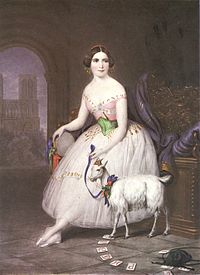Annotation:Esmeralda Polka (La): Difference between revisions
No edit summary |
mNo edit summary |
||
| Line 5: | Line 5: | ||
[[File:esmeralda.JPG|200px|thumb|left|Fanny Cerrito in the title role of the Pugni/Perrot La Esmeralda, London, circa 1844.]] | [[File:esmeralda.JPG|200px|thumb|left|Fanny Cerrito in the title role of the Pugni/Perrot La Esmeralda, London, circa 1844.]] | ||
<br> | <br> | ||
The Esmeralda, sometimes called the Three-Slide Polka, was a ballroom dance popular in America in the second half of the 19th century. It consisted in a combination of steps from the polka and the galop. The music was usually a polka in 2/4 time; occasionally a 6/8 time tune was used. | |||
The Esmeralda, sometimes called the Three-Slide Polka, was a ballroom dance popular in America in the second half of the 19th century. It consisted in a combination of steps | |||
<br> | <br> | ||
<br> | <br> | ||
Revision as of 00:43, 17 August 2020
Back to Esmeralda Polka (La)
ESMERALDA POLKA, LA. Polka (2/4 time). C Major. Standard tuning (fiddle). ABACA. "La Esmeralda" takes its name from a ballet of the same name in 3 acts, 5 scenes, inspired by Victor Hugo's Notre Dame de Paris. It was originally choreographed by Jules Perrot, with music by Cesare Pugni (see also note for "Annotation:Opera Polka").

The Esmeralda, sometimes called the Three-Slide Polka, was a ballroom dance popular in America in the second half of the 19th century. It consisted in a combination of steps from the polka and the galop. The music was usually a polka in 2/4 time; occasionally a 6/8 time tune was used.
Source for notated version:
Printed sources: Manson (Hamilton's Universal Tune Book, vol. 2), 1846; p. 145.
Recorded sources:
